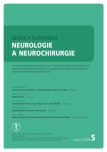Lumbar spine disorder – the new occupational disease
Authors:
E. Ehler 1,2; M. Nakládalová 3; M. Heřman 4,5; P. Urban 6
Authors‘ workplace:
Neurologická klinika Pardubické, nemocnice
1; Fakulta zdravotnických studií, Univerzita Pardubice
2; Klinika pracovního lékařství, FN Olomouc a LF UP v Olomouci
3; Radiologická klinika, LF UP a FN Olomouc
4; Ústav zobrazovacích metod, FZV UP v Olomouci
5; Státní zdravotní ústav, Praha
6
Published in:
Cesk Slov Neurol N 2022; 85(5): 351-362
Category:
Minimonography
doi:
https://doi.org/10.48095/cccsnn2022351
Overview
Minimonography describes the algorithm of the assessment and acknowledgment of the new occupational disease: “chronic lumbar spine disorder caused by heavy physical work,” focusing on the role of a neurologist in this process. The new item has been added to the List of Occupational Diseases by Government Regulation No. 506/2021 Coll. From January 1st, 2023, the illness can be acknowledged and compensated as an occupational disease. However, the necessary prerequisite is the fulfillment of strict assessment standards, which include both clinical and hygienic criteria. The neurologist plays a partial, but significant role in the assessment whether the criteria have been met. Neurologist does not decide whether it is or it is not an occupational disease. Neurologist´s role is to judge if the patient’s disease corresponds to the diagnosis in question, i.e., the chronic lumbar spine disorder having the form of Low Back Pain with and/or without a radicular syndrome. Making the differential diagnosis, neurologist has to rule out other significant causes of the patient’s difficulties. Using seven defined parameters of the neurological examination, neurologist rates the severity of the disease and decides whether it reaches the required degree with respect to the patient’s age. Only if the neurological criteria are met, the acknowledgment of the occupational disease comes into consideration. This is a necessary condition – but it is still inadequate.
Keywords:
neurological examination – MRI – occupational diseases – low back pain – lumbar spine disorder – radicular syndrome – EMG
Sources
1. ČSÚ 2021. Pracovní neschopnost pro nemoc a úraz v České republice – za rok 2020. [online]. Dostupné z URL: https://www.czso.cz/csu/czso/pracovni-neschopnost-pro-nemoc-a-uraz-v-ceske-republice-za-rok-2020.
2. EU 2003. Commission Recommendation of 19 September 2003 concerning the European schedule of occupational diseases (Text with EEA relevance) (notified under document number C (2003) 3297). [online]. Available from: https://eur-lex.europa.eu/legal-content/EN/ALL/?uri=CELEX%3A32003H0670.
3. Hulshof CTJ, Pega F, Neupane S et al. The prevalence of occupational exposure to ergonomic risk factors: a systematic review and meta-analysis from the WHO/ILO Joint Estimates of the Work-related Burden of Disease and Injury. Environ Int 2021; 146 : 106157. doi: 10.1016/j.envint.2020.106157.
4. Lötters F, Burdorf A, Kuiper J et al. Model for the work-relatedness of low-back pain. Scand J Work Environ Health 2003; 29 (6): 431–440. doi: 10.5271/sjweh. 749.
5. Wai EK, Roffey DM, Bishop P et al. Causal assessment of occupational carrying and low back pain: results of a systematic review. Spine J 2010; 10 (7): 628–638. doi: 10.1016/j.spinee.2010.03.027.
6. Roffey DM, Wai EK, Bishop P et al. Causal assessment of occupational sitting and low back pain: results of a systematic review. Spine J 2010; 10 (3): 252–261. doi: 10.1016/j.spinee.2009.12.005.
7. Kuiper JI, Burdorf A, Frings-Dresen MHW et al. Assessing the work-relatedness of nonspecific low-back pain. Scand J Work Environ Health 2005; 31 (3): 237–243.
8. Luoma K, Vehmas T, Grönblad M et al. Relationship of Modic type 1 change with disc degeneration: a prospective MRI study. Skeletal Radiol 2009; 38 (3): 237–244. doi: 10.1007/s00256-008-0611-8.
9. Karppinen J, Solovieva S, Luoma K et al. Modic changes and interleukin 1 gene locus polymorphisms in occupational cohort of middle-aged men. Eur Spine J 2009; 18 (12): 1963–1970. doi: 10.1007/s00586-009-1139-x.
10. ILO 2010. ILO List of Occupational Diseases (revised 2010). [online]. Dostupné z URL: https://www.ilo.org/wcmsp5/groups/public/@ed_protect/@protrav/@safework/documents/publication/wcms_125137.pdf
11. EU 2003. Commission Recommendation of 19 September 2003 concerning the European schedule of occupational diseases (text with EEA relevance) (notified under document number C (2003) 3297) [online]. Dostupné z URL: https://eur-lex.europa.eu/legal-content/EN/ALL/?uri=CELEX%3A32003H0670.
12. Laštovková A, Nakládalová M, Fenclová Z et al. Low-back pain disorders as occupational diseases in the Czech Republic and 22 European countries. Comparison of national systems, related diagnoses and evaluation criteria. Cent Eur J Public Health 2015; 23 (3): 244–251. doi: 10.21101/cejph.a4185.
13. Hlávková J, Lebeda T, Tichý T et al. Evaluation of lumbar spine load with computational method for the purpose of acknowledging low-back disorders as occupational diseases. Centr Eur Public Health 2016; 24 (1): 58–67. doi: 10.21101/cejph.a4332.
14. Gaďourek P, Lebeda T, Hlávková J et al. Použití ergonomického software TECNOMATIX JACK při posuzování pracovní zátěže u onemocnění bederní páteře. In: Osina O, Mušák L. Pracovné lekárstvo a toxikológia, Nové poznatky a skúsenosti 2. Martin: JLF UK 2014.
15. Pešáková L, Hlávková J, Nakládalová M et al. Exposure criteria for evaluating lumbar spine load. Cent Eur J Public Health 2018; 26 (2): 98–103. doi: 10.21101/cejph. a4941.
16. Pešáková l, Nakládalová M, Tichý T et al. Modelové ověření podmínek práce při podezření na profesionální onemocnění bederní páteře. Pracovni Lekarstvi 2018; 70 (1–2): 5–10.
Labels
Paediatric neurology Neurosurgery NeurologyArticle was published in
Czech and Slovak Neurology and Neurosurgery

2022 Issue 5
Most read in this issue
- Lumbar spine disorder – the new occupational disease
- Cenobamate
- Outcomes of facial nerve reconstructive surgery
- Carotid web
